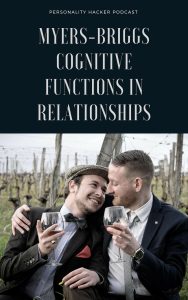Download Episode Here – right click link and select “Save Link As…”
In this episode Joel and Antonia talk about the Myers-Briggs cognitive functions and how they play a role in romantic relationships.
In this podcast you’ll find:
- Dichotomy in Relationships podcast
- Car Model
- Reference Guides for each cognitive function stack
- The Driver function is very unconscious. You do it automatically.
- If you are in a relationship with somebody who suppresses that driver function, it will cause conflict or depression.
- The driver puts you into flow. It energizes you and makes you feel good.
- It’s not good to be in a situation where that function isn’t being allowed expression.
- Get very clear on your dominant process, and your spouse’s, then have a conversation around it so you can both be aware of each other’s needs.
- Determine if you are leading with a learning process or a decision-making process.
- If your Driver is an iNtuitive or Sensing function, you lead with a learning process (referred to as Perceiving process in the podcast).
- If your driver is a Feeling or Thinking function, you lead with a decision making process.
- If one partner leads with a learning process and the other leads with a decision-making process, it can create conflict.
- People who lead with a learning process tend to hesitate before they make decisions. They want more info before they make a decision.
- Someone who leads with a decision-making process is going to come across way more decisive and live their lives in the realm of should statements.
- Two people driving with judging functions can create friction because each is certain how things should be.
- Two people who lead with learning process can take a long time to make a decision.
- A female who leads with a decision-making process and ends up in a relationship with a man who leads with a learning process may feel like she has to make all the decisions. She may feel like she can’t rest into him because he is so slow to make decisions.
- The Copilot is our auxiliary cognitive function. Our growth state. It’s important we work on this process and use it.
- The Copilot is a more conscious part of our personality, and we can have a tendency to bypass it if we want to stay in a comfortable place.
- When we first start working on our copilot, it could be messy. Stay the course!
- Get clear on the needs of your copilot. If you are an extravert and your copilot is introverted, you have to have introverted time.
- Some people just need to know what is going on with you. Be clear about your needs, so the other person doesn’t misunderstand your actions.
- The Tertiary cognitive function (10 yr old) will be the same attitude as the driver. If your driver is introverted, this process will be introverted. It is a comfortable place for us.
- This function is best when used in times of play. Don’t let it run the show. Let it play, like a 10 yr old.
- When we ignore the copilot and stay in the attitude of the driver and tertiary process, it isn’t a good place for a person to be. We call it a loop.
- Figure out how you loop and discuss it openly so each can identify when it is happening.
- Why are you in the loop? What do you need to get back into your copilot?
- A lot of conflicts come from both people being in this 10 yr old process.
- Out of conflict comes intimacy.
- You can build understanding and intimacy through the conflict if you have the awareness to understand what is going on.
- If someone is getting stuck in the 10 yr old and it is a learning process, it can come across as avoidance. Either avoiding info or seeking distraction.
- If someone is getting stuck in 10 yr old and it is a judging or decision-making process it can show up as being resolute and insistent it is right.
- Te/Fe will try to push the outer world. Ti/Fi can look like you are sticking your flag in the ground and refusing to be budged.
- You might be fighting two different games if your spouse is one way and you are the other.
- If one can be aware enough to get out of the 10 yr old, they can help the situation by pulling the other person out of their 10 yr old.
- It’s not about winning or losing. It’s about building intimacy.
- The 10 yr old is the one that you are going to notice coming up more than anything else.
- The inferior process, 3 yr old, has the maturity of a 3 yr old.
- It is not conscious for most people. It feels icky sometimes.
- If you put your mate in a situation where their 3 yr old is exposed and hurt it will be interpreted as a betrayal.
- How does your 3 yr old show up and what would be a massive betrayal for you? What about your spouses 3 yr old. What would be a betrayal of them?
- Look at the car models for each personality side by side.
- See how they compare and contrast.
- What strengths do you share?
- What weaknesses do you share?
- How can compensate for each other’s blind spots?
- Create language and framework around your personalities so you can speak to each other’s strengths and weaknesses.
- Use this knowledge to increase understanding and open conversation.
- Don’t use this as a weapon.
- Use it as a means to improve communication and connection.
- Just having the language solves the majority of conflict.
To subscribe to the podcast, please use the links below:
Subscribe with iTunes
Non iTunes Link
Download The Android App
Subscribe on Soundcloud
Subscribe with Stitcher
Subscribe on Google Play
If you like the podcast and want to help us out in return, please leave an honest rating and review on iTunes by clicking here. It will help the show and its ranking in iTunes immensely! We would be eternally grateful!
Want to learn more?
Discover Your Personal Genius
We want to hear from you. Leave your comments below…



Share:
Podcast - Episode 0159 - Myers-Briggs Dichotomies In Relationships
Podcast - Episode 0161 - Systems Thinking In Relationships
20 comments
Hi Antonia and Joel,
My wife and I have enjoyed working through a lot of your podcasts over the past 6 months and have found them to be very insightful, sometimes uncomfortably so! This one was particularly interesting as we are having some difficulties at the moment, and this has given some little hints as to some of the places we may be going wrong.
One of the things I found fascinating was the discussion about perceiving vs judging driver functions. I’m an ISTP and my wife identifies most with ISTJ, so I have a dominant judging function (Ti) and she has a perceiving function (Si). You described us almost exactly when discussing how one will want to procrastinate and learn about options while the other will want to just make a decision and move on; however, the description was the exact opposite of how we show up! I’m supposed to be the decision maker (in this discussion) and she the perceiver, but it’s very much the opposite was around. I wonder if anyone else found this?
Also, much to my dismay the ISTP and ISTJ don’t share any cogniive functions in their 4 function stack, and I find this creates a lot of conflict in many areas. You mention in this podcast how opposite functions attract, and then give a couple of examples but, unless I misheard/misunderstood, those types share some funcions. I wonder if any of your listeners share a similar ‘complete opposite’ function stack and can comment?
Thanks for all the work you put into this!
Thanks for your comment, Brian! We love hearing from you and consider you a valuable part of our community. :)
Of all your podcasts that I’ve listened to over the years, I have to say that I liked this one the best. Yes, the content was very much worthy of introspection and had mucho “ah-ha” stuff. But the best part about it was that you guys, as I perceived it, were really having a lot of fun doing this one. Now it’s not like you don’t have fun doing podcasts anyhow (the “live podcast” was a hoot!), but I sensed that you guys were really clicking on this one – more so than on others. Talk about “flow”! I did a lot of smiling and chuckling while on the bus to Philadelphia. All of you at PH make more of a difference to people than you may ever know. I, for one, am grateful for the discovery. Thanks for broadening my awareness. Cheers!
When people are opposite types we usually call this a growth relationship. You’re going to come at the world so differently you won’t be able to stop friction from happening. When people are of similar types there may be less friction between the couple, but the challenges come from the outside world (since they share the same general weaknesses). So growth relationships are a good thing – it means you’ve got each other’s blind spots covered. The trick is to maintain appreciation for the ‘other’ even when it’s confusing.
We’ve done a couple of podcasts on growth relationships. I recommend checking them out if you haven’t yet:
www.personalityhacker.com/podcast-episode-0109-three-styles-of-relationships-with-jayson-gaddis/
www.personalityhacker.com/podcast-episode-0110-growth-relationships/
Hope that helps. :)
A
I’d like to thank you for the efforts you’ve put in penning this site.
I really hope to check out the same high-grade content by you in the future as
well. In truth, your creative writing abilities has
encouraged me to get my very own website now ;)